Presenting CLM Content Remotely
- CRM Desktop (Windows)
- iPad
Presenting CLM content remotely allows HCPs to view CLM content on their own devices during calls without being in a meeting. Details about the session, including the link, are shared with the HCPs using social messaging apps, verbally, or with a QR Code®. Selecting the link allows the HCP to view the CLM content in their browser without installing an app.
Users cannot present website content remotely.
CLM content for remote CLM respects the restricted calls, restricted products, allowed products, and segmentations for the attendee account, but does not respect any disabled touch gestures defined on associated Key_Message_vod records.
Configuring Presenting CLM Remotely
To allow end users to create a remote CLM link:
- Grant the CLM integration user the following permissions:
Object
OLS
Record Types
Fields
FLS
CLM_Presentation_vod n/a n/a Allow_Remote_CLM_vod Edit Message_Activity_vod
CRU
Vault_Activity_vod
- Sent_Message_vod
- Vault_Document_Id_vod
- Vault_Document_Major_Version_vod
- Vault_Document_Minor_Version_vod
- Vault_Doc_Name_vod
- Vault_Document_Number_vod
- Vault_Document_Title_vod
- Vault_Domain_vod
Edit
Sent_Message_vod
CRU
Content_vod
- Account_vod
- Call_vod
- Capture_Datetime_vod
- Clm_Presentation_vod
- Detail_Group_vod
- Details_vod
- Engage_Link_vod
- Key_Message_vod
- Message_Config_Values_vod
- Mobile_ID_vod
- Opened_vod
- Product_vod
- Sent_Datetime_vod
- Sent_From_Platform_vod
- Sent_Phrase_vod
- Sent_Via_vod
- Shortened_Engage_Link_vod
- To_vod
- Transaction_Type_vod
- User_vod
- VExternal_Id_vod
Edit
- Clicked_vod
- Click_Count_vod
- Downloaded_vod
- Download_Count_vod
- Viewed_vod
- View_Count_vod
Read - Grant the Engage post-processing integration user the following permissions:
Object
OLS
Record Types
Fields
FLS
Message_Activity_vod
CRU
Message_Activity_vod - Activity_vod
- Activity_Datetime_vod
- Client_Device_vod
- Client_Name_vod
- Client_OS_vod
- Client_Type_vod
- IP_Address_vod
- Sent_Message_vod
- User_Agent_vod
Edit
Sent_Message_vod
CRU
Content_vod
- Account_vod
- Call_vod
- Capture_Datetime_vod
- Clm_Presentation_vod
- Detail_Group_vod
- Details_vod
- Engage_Link_vod
- Key_Message_vod
- Message_Config_Values_vod
- Mobile_ID_vod
- Opened_vod
- Product_vod
- Sent_Datetime_vod
- Sent_From_Platform_vod
- Sent_Phrase_vod
- Sent_Via_vod
- Shortened_Engage_Link_vod
- To_vod
- Transaction_Type_vod
- User_vod
- VExternal_Id_vod
Edit
- Clicked_vod
- Click_Count_vod
- Downloaded_vod
- Download_Count_vod
- Viewed_vod
- View_Count_vod
Read - Grant end users the following permissions:
Object
OLS
Record Types
Fields
FLS
Call2_vod
n/a
n/a
- Remote_CLM_ID_vod
- Remote_CLM_Participant_URL_vod
- Remote_CLM_Presenter_URL_vod
- Remote_CLM_UUID_vod
Edit
Call2_Key_Message_vod
n/a
n/a
Share_Channel_vod
Edit
CLM_Presentation_vod
n/a
n/a
Allow_Remote_CLM_vod
Read
Message_Activity_vod
R
n/a - Activity_vod
- Activity_Datetime_vod
- Client_Device_vod
- Client_Name_vod
- Client_OS_vod
- Client_Type_vod
- IP_Address_vod
- Sent_Message_vod
- User_Agent_vod
Read
Multichannel_Activity_vod (Only for CRM Desktop (Windows) users)
n/a
n/a
- Remote_CLM_ID_vod
- Remote_CLM_Participant_URL_vod
- Remote_CLM_Presenter_URL_vod
- Remote_CLM_UUID_vod
Edit
Sent_Message_vod
CRU
Content_vod
- Account_vod
- Call_vod
- Capture_Datetime_vod
- Clm_Presentation_vod
- Detail_Group_vod
- Details_vod
- Engage_Link_vod
- Key_Message_vod
- Message_Config_Values_vod
- Mobile_ID_vod
- Multichannel_Activity_vod (Only for CRM Desktop (Windows) users)
- Opened_vod
- Product_vod
- Sent_Datetime_vod
- Sent_From_Platform_vod
- Sent_Phrase_vod
- Sent_Via_vod
- Shortened_Engage_Link_vod
- Status_vod
- To_vod
- Transaction_Type_vod
- User_vod
- VExternal_Id_vod
Edit
- Clicked_vod
- Click_Count_vod
- Downloaded_vod
- Download_Count_vod
- Viewed_vod
- View_Count_vod
Read - Enable all the picklist values for following fields on the Sent_Message_vod object for all available record types:
- Sent_Via_vod
- Transaction_Type_vod
- Navigate to Setup > Custom Code > Custom Settings > Engage Settings.
- Select New for Default Organization Level Value to define org-wide settings, or select New in the Setup Owner table to create profile-specific settings.
- Populate the following Engage Settings appropriately:
- ENGAGE_LINK_ACCOUNT_SELECTION_vod – Determines if users must select an account before sending a web link. Populate with one of the following values:
- 0 – Users are required to select an account. This is the default value.
- 1 – Users cannot select an account. After selecting a sharing option, users can select the recipient if not already populated.
- ENGAGE_LINK_APPS_vod – References the ENGAGE_LINK_APPS;;EngageLink Veeva Message. Edit the list in the Veeva Message to control the number and order of sharing options available for users to send website links with accounts. Populate the list using the format App1;;App2. Different options are available on different platforms:
Sharing Option
Supported Platforms
Messages
- iPad
- iPhone
WhatsApp
- CRM Desktop (Windows)
- iPad
- iPhone
LINE
- iPad
- iPhone
LINEWORKS
- CRM Desktop (Windows)
The LINEWORKS app launches in the default browser.
- iPad
- iPhone
EngageConnect
EngageConnect cannot be configured with EngageChat.
- iPad
- iPhone
EngageChat
EngageChat cannot be configured with EngageConnect. Additionally, the Engage tab must be configured to use Engage Chat.
- iPad
- iPhone
CopyURL
This includes QR code.
- CRM Desktop (Windows)
- iPad
- iPhone
- Ensure the appropriate VMOCs are active for the following objects:
- Sent_Message_vod, with the following where clause:
- WHERE (Account_vod__r.Name != NULL AND CreatedDate = LAST_N_DAYS:90)
- Multichannel_Activity_vod
- Engage_Link_Settings_vod
To test Remote CLM functionality in a sandbox CRM org, admins must also connect the sandbox org to the Engage sandbox.
Enabling Remote CLM Content in Vault
To allow a CLM presentation synced from Vault to be shared via remote CLM, content admins in Vault must ensure the Publish to CRM (Remote CLM) (publish_for_veeva_crm_remote_clm__v) field is selected on the presentation. This field maps to the Allow_Remote_CLM_vod field on the CLM_Presentation_vod object in CRM, which determines whether the button to start remote CLM for the presentation displays to users.
Content admins must republish existing auto-published content by selecting No for the Publish to Veeva CRM (CLM) field, saving, then selecting Yes again. For content with manually generated distribution packages before 22R2, admins must perform the following steps to republish each piece of content:
- Select No for the Publish for Veeva CRM (CLM) field and save.
- Download the distribution package.
- Delete the distribution package from Vault.
- Upload the distribution package back into Vault.
- Select Yes for the Publish for Veeva CRM (CLM) field and save.
Remote CLM Content Guidelines
Only content published from Vault is supported, including auto-published content, binders and slides, and content created via Create Presentation. The following content packaging formats are supported:
- Images
- Videos
- HTML
If HTML content uses a third-party JavaScript library impacting click event coordinates, then the content will not display as expected during remote CLM.
- PDF, including PDF files and PDF slides in presentations
- goToSlide
The following content packaging formats and assets are not supported:
- PowerPoint
- AR
- Shared resources
- External links
When a user selects an external link and launches the browser, the browser window is not displayed to the attendee
- Embedded videos
- Embedded overlays
Defining SMS and WhatsApp Phone Numbers
Admins can define the SMS and WhatsApp phone numbers for an account. This automatically populates the recipient phone number when users send links to the account using Messages and WhatsApp.
On CRM Desktop (Windows) and iPad, if a phone number is populated for an account, it is automatically populated in the messaging app, regardless of the ENGAGE_LINK_ACCOUNT_SELECTION_vod Engage Setting. If the phone number is not populated for an account, the ENGAGE_LINK_ACCOUNT_SELECTION_vod Engage Setting determines the account selection behavior.
To define the SMS/WhatsApp phone number for an account:
- Grant end users FLS read permission to the following fields on the Account object:
- SMS_vod
- WhatsApp_vod
Since WhatsApp does not have an iPad app, WhatsApp Web launches in the browser on the iPad platform. Veeva does not control the behavior of WhatsApp Web.
- Navigate to the appropriate Account record.
- Select Edit.
- Populate the SMS_vod or WhatsApp_vod fields.
A phone number must be only digits (no symbols), including the country code, and must not contain any leading zeros, for example, 11234567890.
Presenting CLM Content Remotely on iPad
Users can select Present Remotely from the More Actions button of a presentation in the following entry points:
- Presentation thumbnail in the media library
- Presentation slide library
- Specific slide in a presentation
- Presentation displayed in standard search results. Advanced text search is not supported.
Users must have an active internet connection to start presenting remotely.
To start presenting CLM content remotely:
- Select the More Actions button.
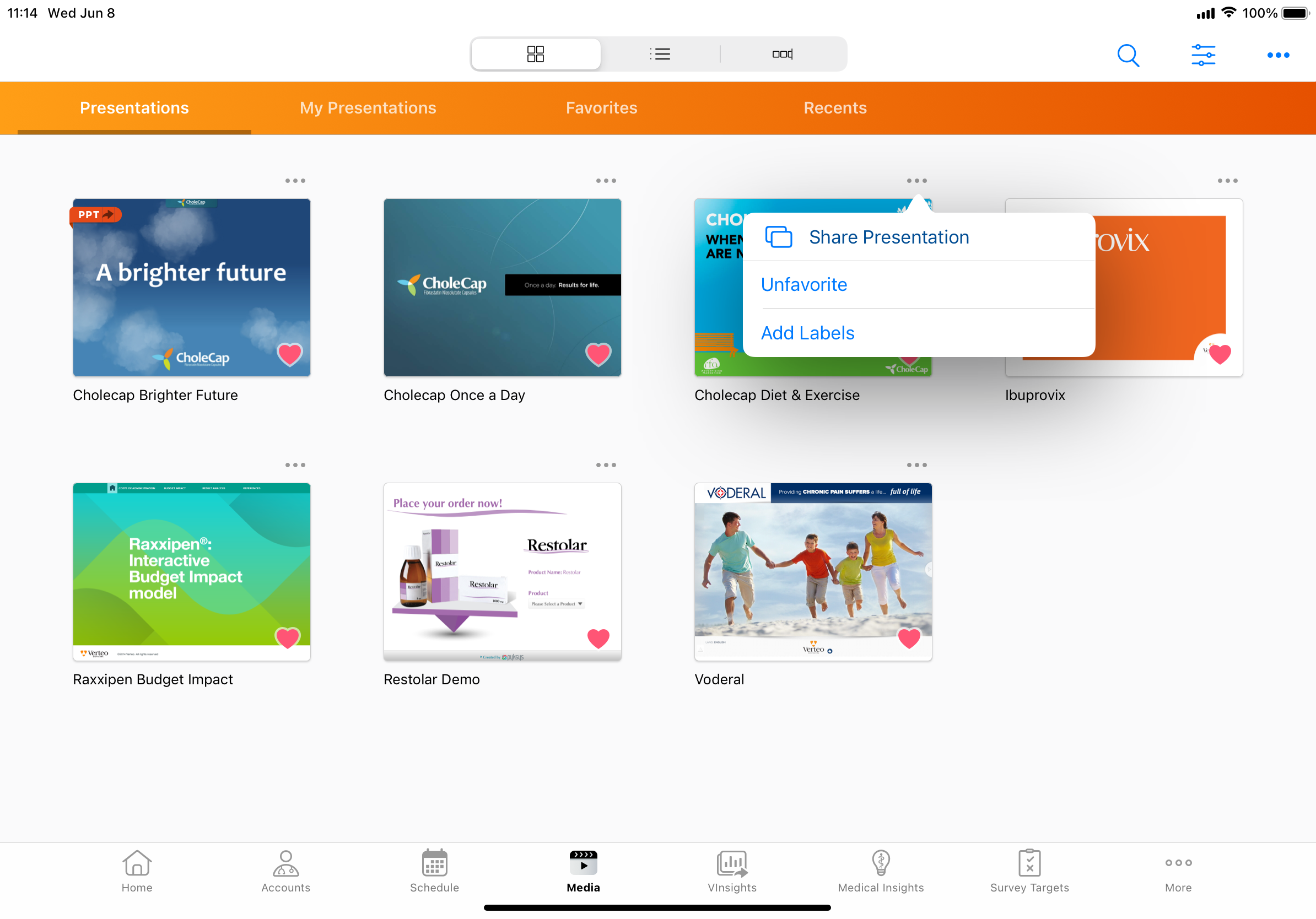
- Select Present Remotely.
- Select the appropriate attendee account, if applicable.
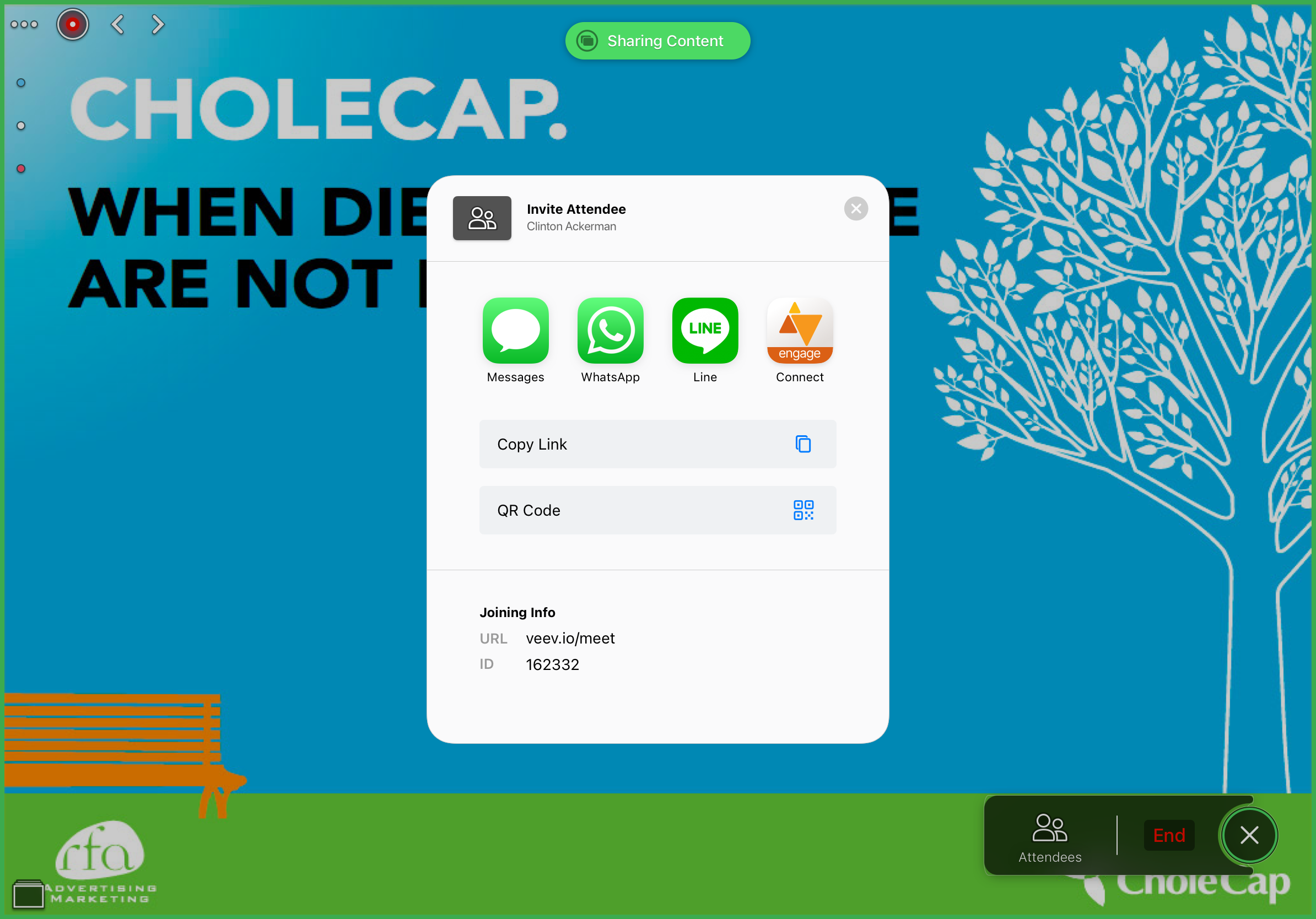
- Select the appropriate sharing option or verbally share the link details, including the ID, with the attendee to allow them to start viewing the CLM presentation.
The user can only share the link details with one attendee at a time.
Users cannot present CLM content remotely during an Engage meeting.
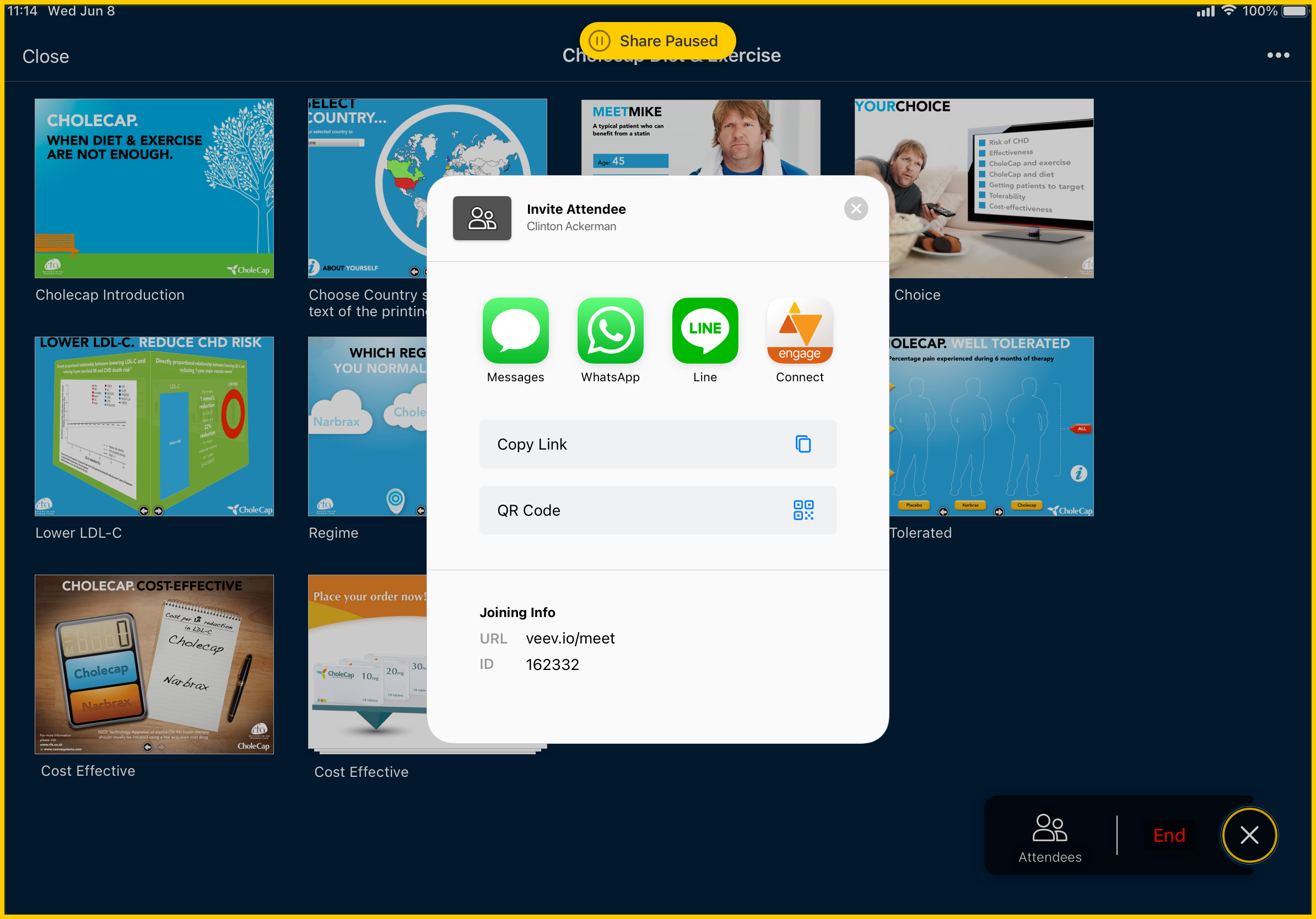
Sharing begins once the first slide loads and pauses when the user views the slide library for the presentation.
When sharing a video slide, users must select the pop-up message to play the video.

Select the Attendees button in the meeting ribbon to view the attendees, including the user. Select Invite to invite another attendee to view the presentation.
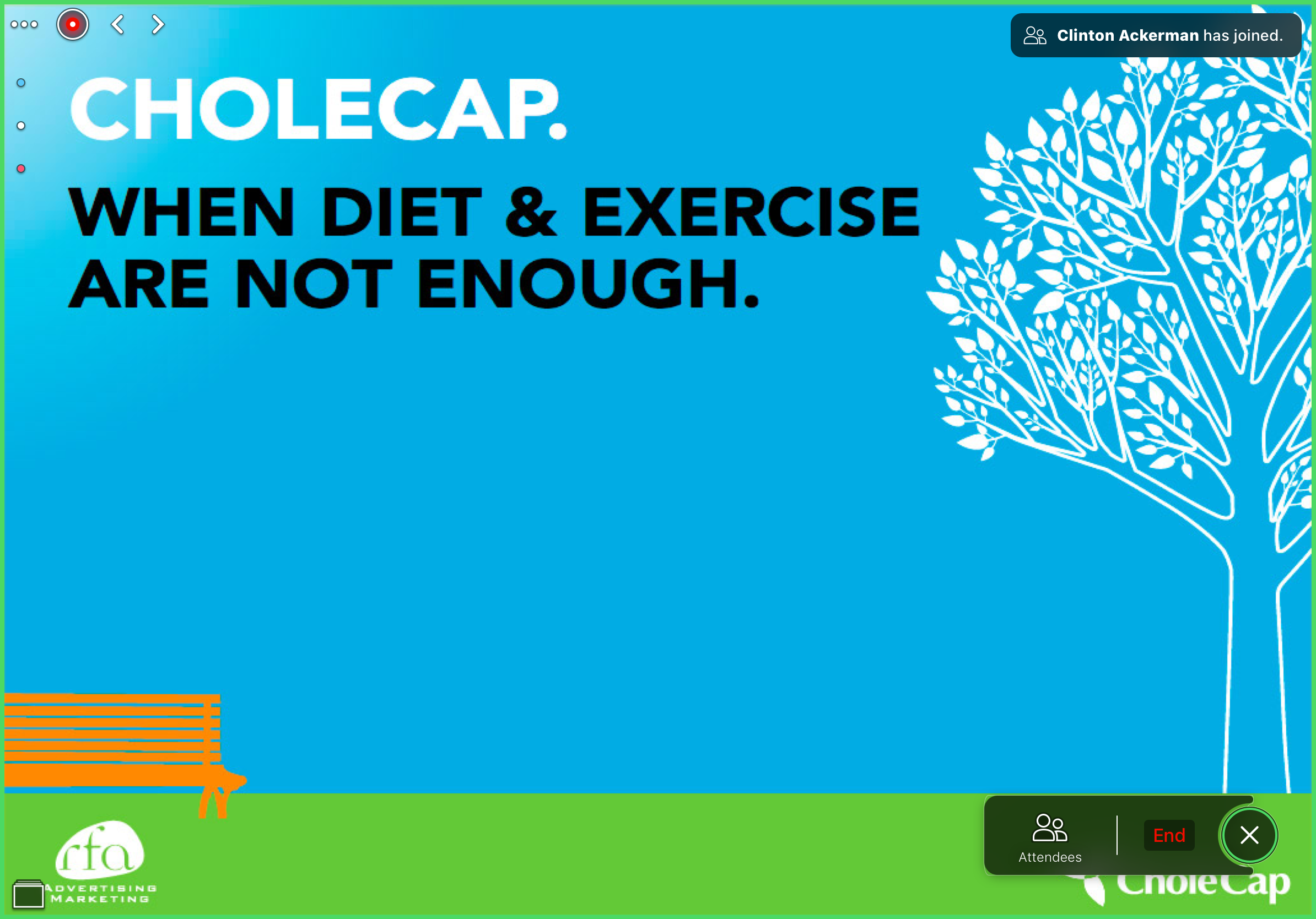
A notification displays when an attendee joins or leaves remote CLM.
To switch presentations while presenting remotely:
- Select the slide sorter button.
- Select Find Presentation to display the media library.
- Find or search for the appropriate presentation.
- Select the presentation to share.

Users can stop sharing CLM content by selecting the End button in the meeting ribbon, then selecting End in the confirmation popup, or by selecting Done in the More Actions menu.
Presenting remotely automatically ends if there is no user interaction with the device screen for 5 minutes. A confirmation popup to stop displaying content displays and users have 60 seconds to be active again before it ends.
Ending remote CLM does not expire the link, which means users can share CLM content with the HCP again with the same link details. Users must launch the media library from the call report associated with the previous remote CLM activity, then start remote CLM for the appropriate presentation. The link expires two hours after the most recently ended remote CLM activity.

Users are prompted to select an account with which to associate the tracked remote CLM activity if one was not selected before sharing the presentation.
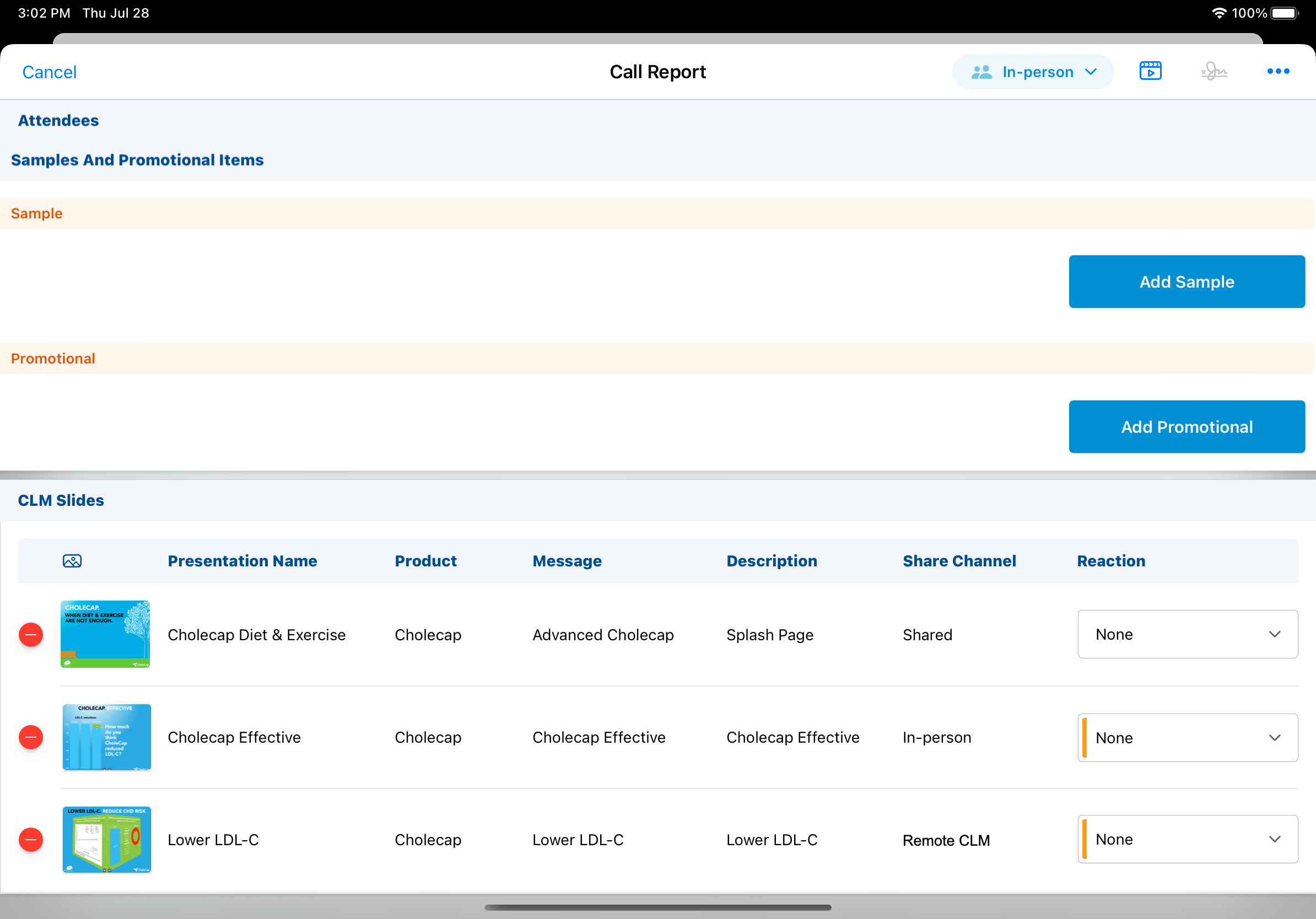
After creating a call and confirming the end of remote CLM, the CLM Details section of the call report displays, allowing users to review the activity. The Share_Channel_vod field for each tracked call key message is stamped with Remote_CLM_vod.
Presenting CLM Remotely on CRM Desktop (Windows)
On CRM Desktop (Windows), users can select Present Remotely in a presentation window in the following scenarios:
- During call mode – The user presents remotely after initiating call mode from the call report on the Browser or from the high performance call report. The remote CLM activity is tracked on the call report.
-

- Sharing a presentation in Save for Later call mode – The user presents remotely after initiating Save for Later call mode from the media library. The remote CLM activity is tracked as an unassigned presentation.
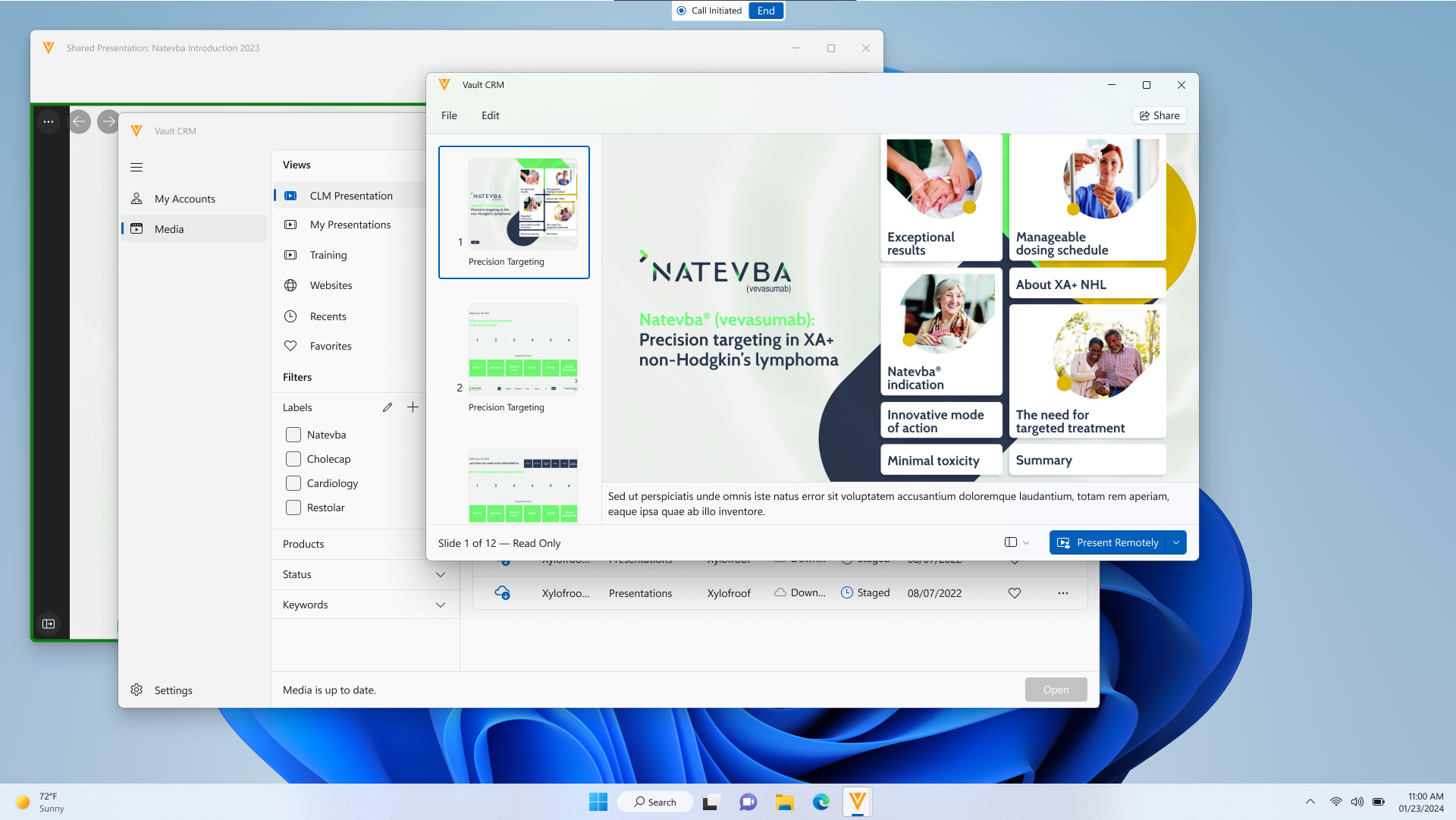
- Without initiating call mode or Save for Later call mode – The user selects Present Remotely from the Start Slideshow dropdown menu and initiates Save for Later call mode. The remote activity is tracked as an unassigned presentation.

Users must have an active internet connection to start presenting remotely. Users cannot present CLM content remotely during an Engage meeting.
To present CLM remotely:
- Open the appropriate presentation from the media library.
- Select Present Remotely.

- Select the appropriate attendee account, if applicable.

- Select the appropriate sharing option or verbally share the link details, including the ID, with the attendee to allow them to start viewing the CLM presentation.
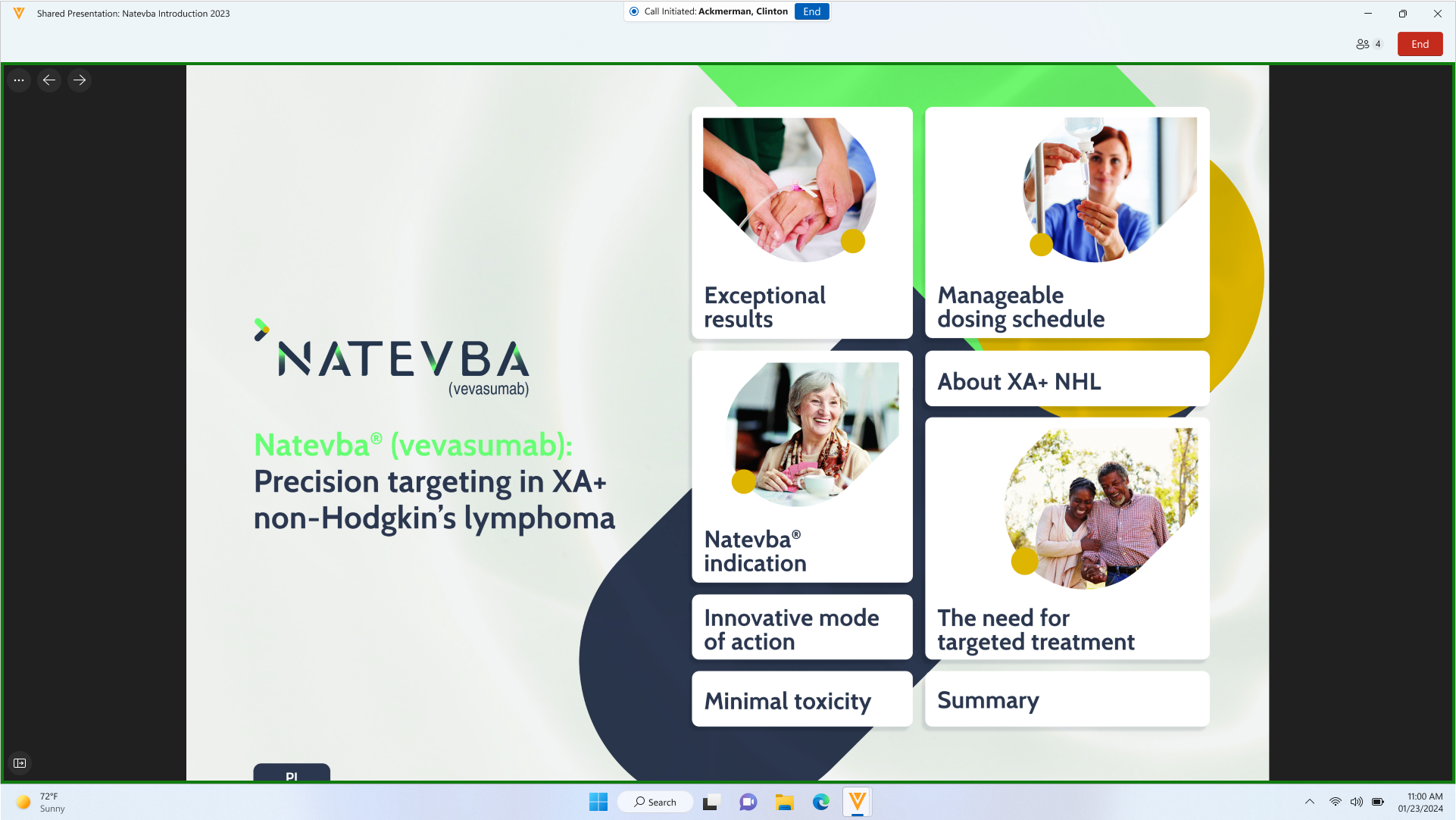
Sharing begins once the user closes the share modal and the first slide loads.
When presenting remotely, presentations display in Slide Show View by default. Users can switch to Window View.
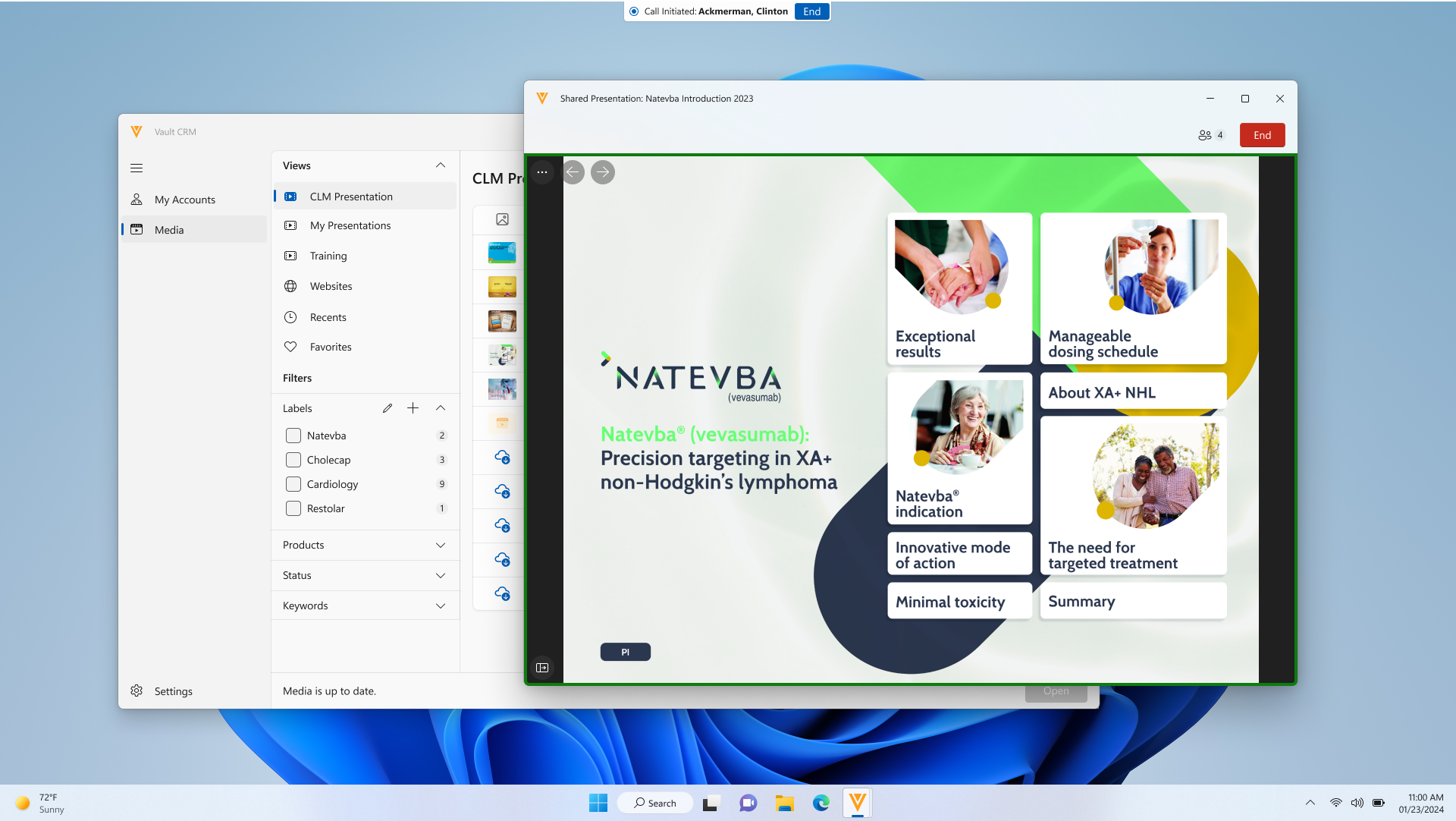
Users can select the attendees button in the top right corner to view the current attendees and invite other attendees.

To switch presentations while presenting remotely:
- Navigate to the media library or to a presentation in Normal View.
- Select Present Remotely.
To stop presenting remotely without ending call mode:
- Perform one of the following actions:
- Select End in the top right corner of the presentation
- Select the X button in the top right corner of the window
- Select End Slideshow from the More Actions button
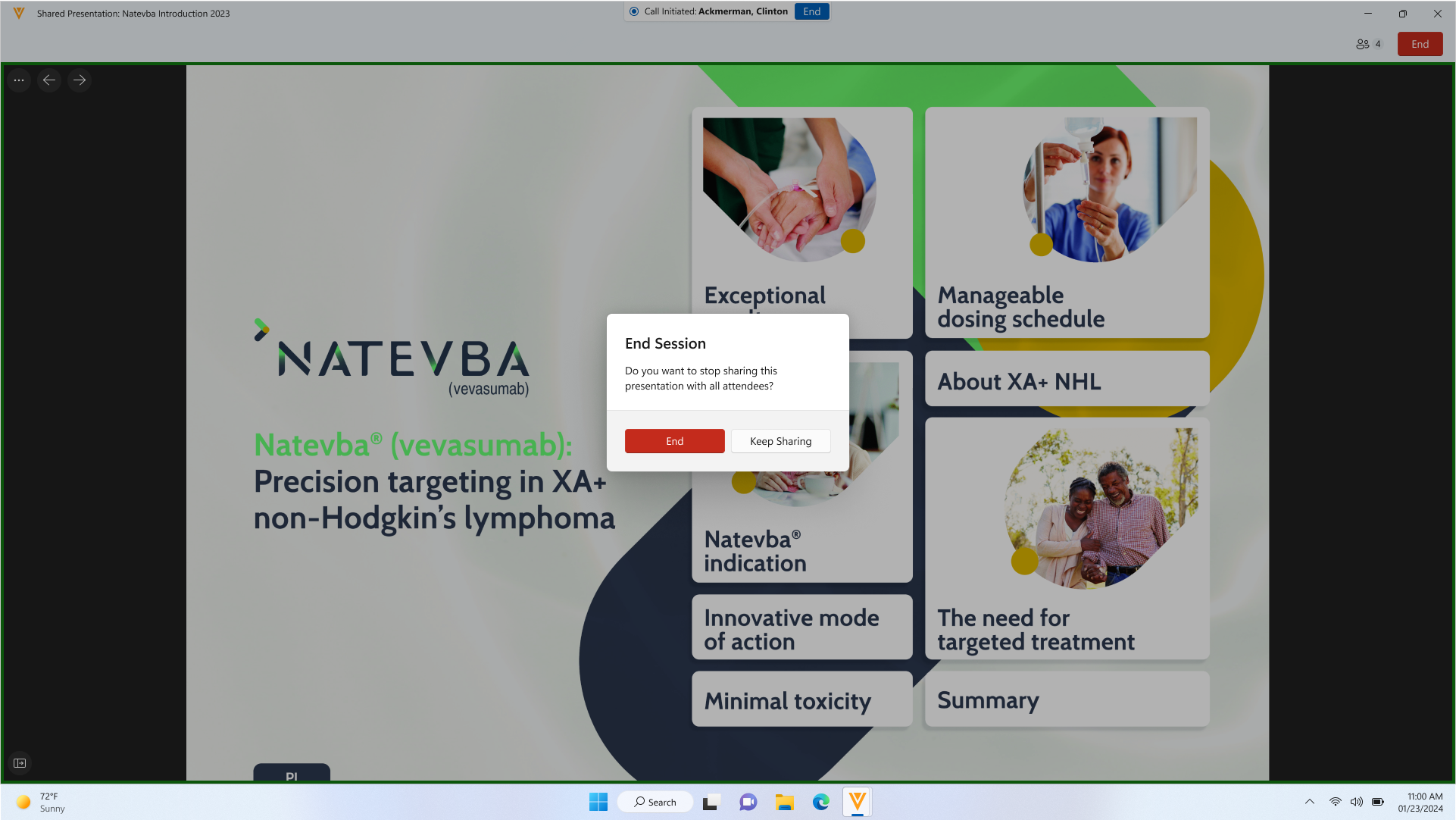
- Select End in the confirmation popup.
To stop presenting remotely and end call mode:
- Select End in the call mode banner.
- Select End Call in the confirmation popup.
Tracking Remote CLM
When a user selects a sharing option to send remote CLM details with an attendee, a Sent_Message_vod record is created and stamped with the following information:
|
Field |
Value |
|---|---|
|
Record Type |
Content_vod |
|
Account |
Lookup to the attendee account |
|
User |
Lookup to the user who sent the session details |
|
Engage Link |
Participant URL. If there is a Call2_vod record associated with the session, this link is also stamped in the Remote_CLM_Participant_URL_vod field on the record. |
|
Shortened Engage Link |
The shortened Participant URL |
|
Capture Datetime |
Datetime at which the user selected the sharing option |
|
Sent from Platform |
iPad_CRM_vod |
|
Shared Via |
The app used to send the session details:
|
|
Transaction Type |
Remote_CLM_Link_vod |
|
Call |
The associated Call2_vod record |
|
Mobile Id |
System-generated Id |
|
VExternal Id |
The unique identifier of the shortened Participant URL |



